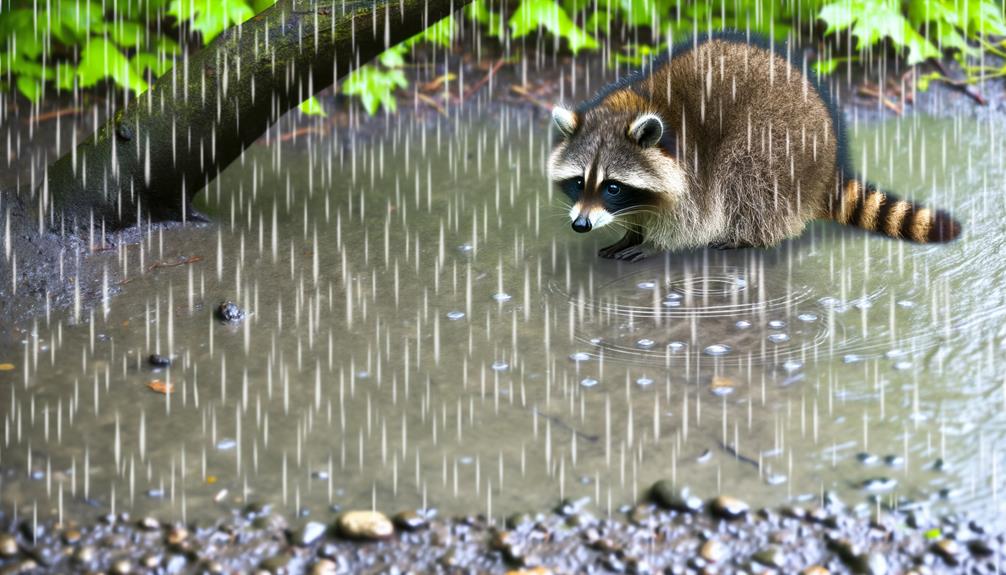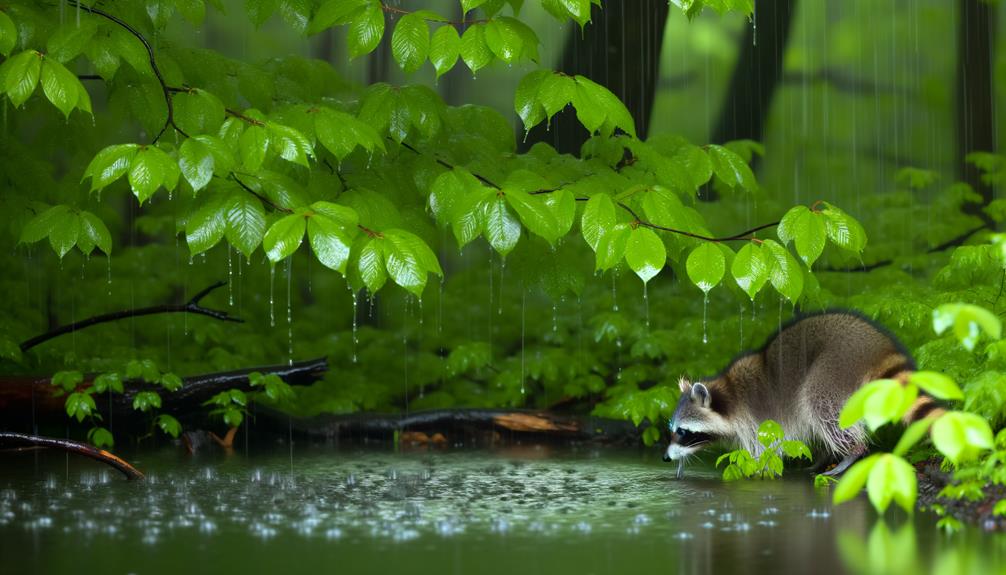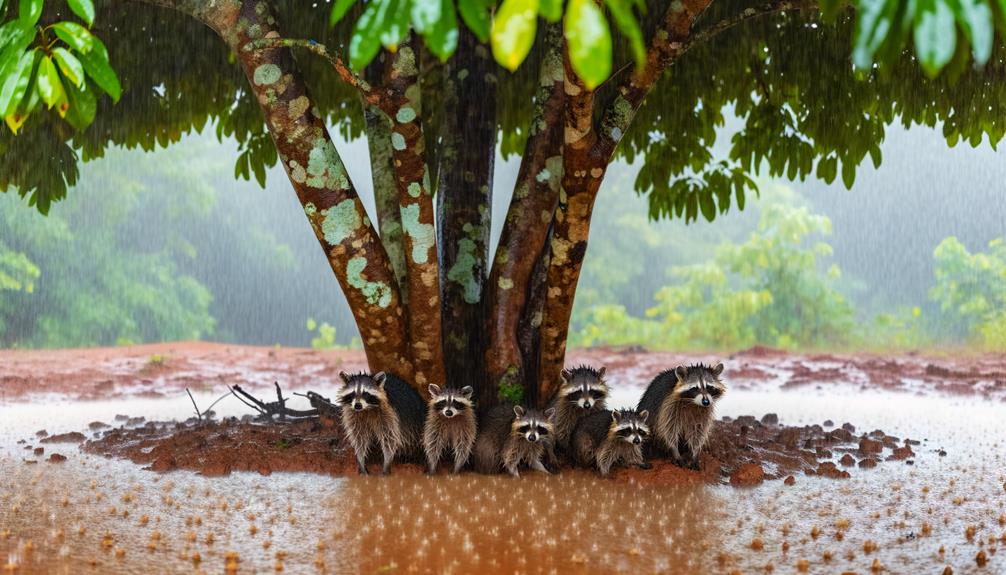How Do Raccoons Like Rain: Observing Behavior
Raccoons have developed several adaptations to cope with rainy conditions. Their dense, oily fur provides insulation and water resistance.
During rain, raccoons often seek shelter in tree hollows, burrows, or dense vegetation, maintaining their activity patterns. They engage in increased grooming and use their keen sense of touch to locate food sources efficiently.
Despite the challenges of wet weather, they exhibit remarkable foraging efficiency and adjust their strategies for survival. To understand more about how raccoons navigate their environments during rain, including their intricate foraging techniques and sought shelters, further information is available.

Key Takeaways
- Raccoons adapt their activity patterns during rainfall to ensure survival.
- They seek temporary shelter in tree hollows, burrows, or dense vegetation when it rains.
- Increased grooming behaviors are observed in raccoons to maintain fur insulation during wet weather.
- Raccoons use their acute sense of touch and smell to forage efficiently even in heavy rain.
- They exhibit increased nocturnal activity during rainfall for predator protection and energy conservation.
Raccoon Behavior in Rain

During periods of rainfall, raccoons exhibit a range of adaptive behaviors that enable them to navigate their environment effectively. Evidence suggests that these nocturnal mammals alter their activity patterns to avoid heavy rain, preferring to forage during light showers or after the rain has subsided.
Raccoons are known to seek temporary shelter in tree hollows, abandoned burrows, or dense vegetation to stay dry. Additionally, they exhibit increased grooming behaviors to maintain their fur's insulating properties and prevent hypothermia.
Field observations highlight that raccoons utilize their acute sense of touch to locate food sources, as rain can obscure scent trails. These behaviors demonstrate the raccoon's remarkable ability to adjust its strategies for survival in varying weather conditions.
Biological Adaptations
Raccoons possess several biological adaptations that enable them to thrive in rainy environments. Their dense fur provides effective insulation, keeping them warm despite wet conditions. The fur's oily outer layer offers water resistance, reducing the risk of hypothermia.
In addition, raccoons have highly dexterous front paws, which remain functional even when wet, allowing them to manipulate objects and access food sources. Their sharp claws provide a stable grip on slippery surfaces, aiding in climbing and maneuvering wet terrain.
Moreover, raccoons boast excellent night vision, which is particularly advantageous during the low-light conditions typical of storms. These adaptations collectively ensure that raccoons remain active and resilient, even in adverse weather conditions, underscoring their ability to endure and exploit rainy environments.
Foraging During Downpours

Despite inclement weather, raccoons exhibit remarkable foraging efficiency during downpours, leveraging their unique adaptations to secure food. Their dexterous front paws allow them to manipulate objects and uncover hidden food sources, even in wet conditions.
Studies have shown that raccoons possess highly developed tactile senses, enabling them to detect and identify food by touch alone. Additionally, raccoons' keen sense of smell remains effective despite heavy rainfall, guiding them to potential food sources.
These adaptive traits allow raccoons to forage successfully during rain, ensuring a consistent food supply. Observations indicate that rain may even provide advantages, such as reduced competition and increased availability of earthworms and other invertebrates brought to the surface by the water.
Shelter and Safety
In wet weather, raccoons seek out secure shelters to protect themselves from potential hazards and maintain their well-being. These nocturnal animals are adept at finding or creating safe havens that provide adequate cover from the rain and predators. Common shelters include hollow trees, abandoned burrows, and human-made structures like attics or sheds. The choice of shelter is influenced by availability and proximity to food sources.
| Shelter Type | Benefits |
|---|---|
| Hollow Trees | Natural insulation, predator safety |
| Abandoned Burrows | Concealment, protection from elements |
| Attics | Warmth, easy access to food |
| Sheds | Dryness, seclusion |
This strategic behavior underscores the raccoon's adaptability and resourcefulness in ensuring their safety during inclement weather.
Impact on Daily Routines

Inclement weather greatly alters the daily routines of raccoons, compelling them to adjust their foraging and activity patterns to mitigate the challenges posed by the rain. Research indicates that raccoons exhibit increased nocturnal activity during rainfall, as the cover of darkness and sound of rain may provide additional protection from predators.
Additionally, wet conditions can impact the availability of certain food sources, prompting raccoons to seek alternative foraging sites. Rain can also affect their grooming behavior, as raccoons are meticulous about keeping their fur dry to maintain insulation and buoyancy.
Consequently, raccoons may spend extended periods in their dens during heavy rain, reducing exposure to the elements and conserving energy until more favorable conditions arise.
Conclusion
A study found that raccoons spend approximately 30% more time foraging during rain compared to dry conditions, suggesting rain may enhance their food-seeking activities.
This behavior is supported by their biological adaptations such as a dense undercoat and dexterous front paws, enabling raccoons to efficiently navigate wet environments.
Consequently, rain notably influences raccoons' foraging habits and shelter-seeking behaviors, impacting their daily routines and overall survival strategies in their natural habitats.






